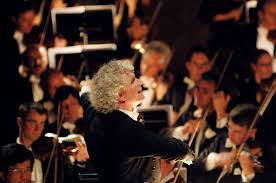Berliner Philharmoniker
Sir Simon Rattle, conductor
Tuesday, November 17, 8 pm
Hill Auditorium

This is THE perfect orchestra experience you have been looking for. Founded during UMS’s third season in 1882, the Berliner Philharmoniker has long been considered one of the world’s finest orchestras.

To quote from the UMS website:-
<start quote>
Sir Simon Rattle, their new music director, has conducted many of the world’s great orchestras. In addition to his duties in Berlin, he regularly guest conducts the Vienna Philharmonic, the Philadelphia Orchestra, and other celebrated ensembles. Rattle makes his UMS debut with this appearance, which features Brahms’s final two symphonies as well as film music composed by Schoenberg. This exclusive tour will include only a handful of US cities — New York, Chicago, Boston, and Ann Arbor.
Please note that the Berliner Philharmoniker has requested that late seating for this performance occur at intermission — after the first complete work on the program.
Program
· Brahms : Symphony No. 3 in F Major, Op. 90 (1883)
· Schoenberg : Begleitmusik zu einer Lichstspielszene, Op. 34 (1929-30)
· Brahms : Symphony No. 4 in e minor, Op. 98 (1884-5)
<end quote>
On 18 December 2008, the Orchestra announced the creation of a Digital Concert Hall: this new Internet platform will enable music fans all over the world to see and hear the Philharmonic’s concerts – live or on demand. There was a free performance sponsored by the Deutsch Bank around two months back. But I had missed it. So I am so excited to see the real deal.
Student rush tickets are difficult to get. But there might be some rush tickets at the box office on the day of the performance due to cancellations. See you there, folks.
Krithika, [art]seen reviewer
Krithika loves to get comments 🙂

